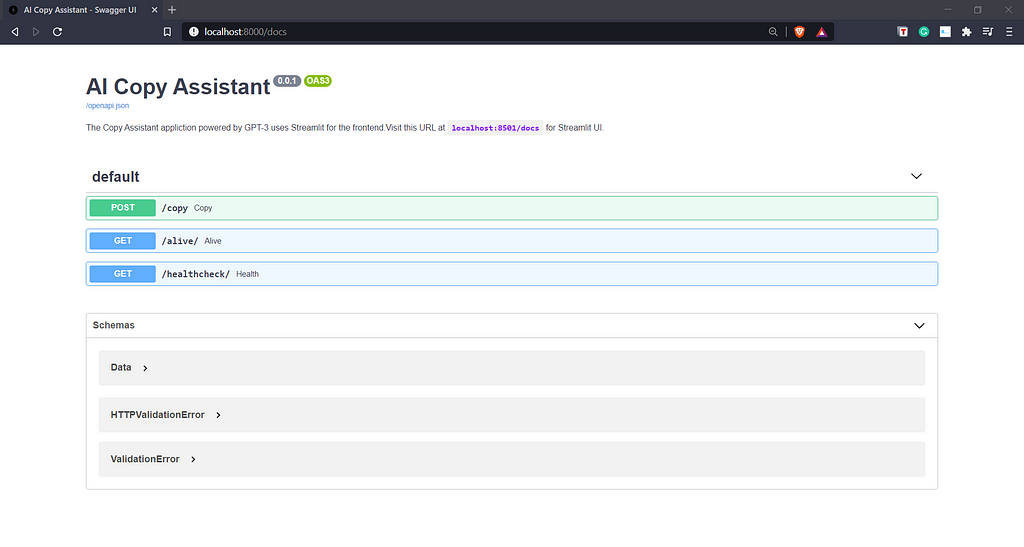
AI Copy Assistant Powered by GPT-3
Last Updated on January 6, 2023 by Editorial Team
Author(s): Shubham Saboo
Natural Language Processing
Generate creatively crafted professional marketing copies in minutes by leveraging the world’s most advanced language model.

Pre-Requisites
I have collected the dots in the form of articles, please go through the below articles in the same order to connect the dots and understand the key tech stack behind Copy Assistant- an application powered by GPT-3:
- FastAPI — The Spiffy Way Beyond Flask!
- Streamlit — Revolutionizing Data App Creation
- Brief Introduction to GPT-3
GPT-3 v/s Human Brain
GPT-3 has gained a lot of attention from the tech community because of its ability to perform natural language tasks that are convincingly human-like. Some have even suggested that GPT-3 (by OpenAI), is the first step towards artificial general intelligence (AGI), the ability to understand or perform any task a human can. Apart from all the capabilities that a machine can have, the biggest differentiating factor between a human and an AI is the capability to think on its own. Based on the breathless coverage in the area of neurosciences experiments have shown that there is a contrast difference between the “appearance of language” and the “capacity to think”.
Natural language and thoughts aren’t the same thing but still are intimately connected to each other. Many people assume that language or expression is the ultimate level of thoughts. But GPT-3 has shown us that language can be explicitly generated with the need of a living soul. In today’s world, all it needs to generate human-like language is an abundant amount of data.
GPT-3 stands on the shoulder of giants (nanos gigantum humeris insidentes) due to which today its capable of producing highly coherent and contextually relevant results boasting a wide range of vocabulary, a human-like touch in the responses owing to an unprecedentedly large universe of a knowledge base.

Application walkthrough
Now I will walk you through the AI copy assistant application step by step:
While creating any GPT-3 application the first and foremost thing to consider is the design and content of the training prompt. Prompt design is the most significant process in priming the GPT-3 model to give a favorable and contextual response.
As a rule of thumb while designing the training prompt is to aim towards getting a zero shot response from the model, if that isn’t possible move forward with few examples rather than providing it with an entire corpus. The standrad flow for training prompt design should look like: Zero Shot → Few Shots →Corpus based Priming.
For designing the training prompt for the copy assistant application, I have strategically used the following data points as the components of the training prompt:
- Product: A few words to tell the copy assistant about the product or simply specifying the product for which we need the ad copy to be generated.
- Audience: A minimalist relevant information about the target group or audience for the particular product, will help GPT-3 to come up with a proper contextual response.
- Promotions: This component provides the flexibility to the users to include promotional offers (if any) for the respective products or to simply specify None if there aren’t any promotional offers. It will help the model to generated precisely targeted ad copies.
- Headline/Title: It includes a catchy title/headline consisting of few words that will act as a hook for the audience towards the product.
- Ad Copy/Description: It includes a one or two-liner description about the product that takes in all the above data points to generate a creative and efficient ad-copy.


Let’s see an example in action, to truly understand the power of GPT-3 in generating ad copies. In the below example, we will generate a few emails by providing minimal instructions to the AI copy assistant.
Conclusion
GPT-3 will redefine the way we currently look at creative arts like writing ad copies, the screenplay for movies, song lyrics, or painting. It will venture into the creative space up to an extent where the art generated by AI will be indistinguishable from the art pieces created by humans. GPT-3 is the closest thing that we have today to artificial general intelligence, in some way it's the foundational steps towards AGI (artificial general intelligence).
References
- https://en.wikipedia.org/wiki/GPT-3
- https://openai.com/blog/openai-api
- https://theconversation.com/gpt-3-new-ai-can-write-like-a-human-but-dont-mistake-that-for-thinking-neuroscientist-146082
- https://lacker.io/ai/2020/07/06/giving-gpt-3-a-turing-test.html
If you would like to learn more or want to me write more on this subject, feel free to reach out.
My social links: LinkedIn| Twitter | Github

If you liked this post or found it helpful, please take a minute to press the clap button, it increases the post visibility for other medium users.
AI Copy Assistant Powered by GPT-3 was originally published in Towards AI on Medium, where people are continuing the conversation by highlighting and responding to this story.
Published via Towards AI
Take our 90+ lesson From Beginner to Advanced LLM Developer Certification: From choosing a project to deploying a working product this is the most comprehensive and practical LLM course out there!
Towards AI has published Building LLMs for Production—our 470+ page guide to mastering LLMs with practical projects and expert insights!

Discover Your Dream AI Career at Towards AI Jobs
Towards AI has built a jobs board tailored specifically to Machine Learning and Data Science Jobs and Skills. Our software searches for live AI jobs each hour, labels and categorises them and makes them easily searchable. Explore over 40,000 live jobs today with Towards AI Jobs!
Note: Content contains the views of the contributing authors and not Towards AI.















